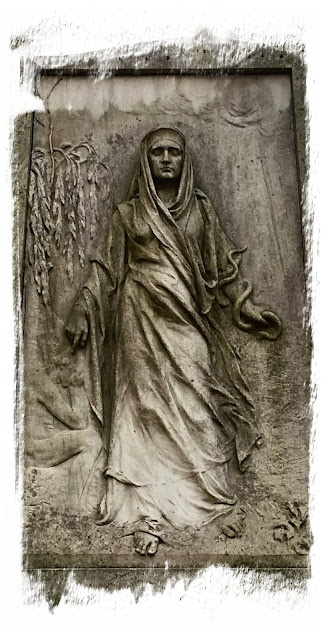I
have a love / fascination / curiosity for visiting cemeteries when I'm in
foreign cities ... and what attracts me more than anything is the wonderful art
that exists in European burial grounds - in particular the amazing sculptures
dotted throughout the cemeteries.
These
are not tissy show pieces commissioned by some spoilt princess for her boudoir
that after time end up in expensive museums, under special lighting effects and more often than not, behind barriers, but rather robust ( in most cases
... ) effigies reflecting the lives lived by real people or the wishes of
those left behind.
Getting off the city tram, the first sight that greets you are the dozens of flower and wreath stalls that crowd around the entrance gates ...
The
Vienna Central Cemetery ( Zentralfriedhof ) is one of the largest cemeteries in
the world - largest by number of interred in Europe and the most famous cemetery
among Vienna's nearly 50 cemeteries.
Unlike
many others, the Vienna Central Cemetery is not one that has evolved slowly
with the passing of time. The decision to establish a new, big cemetery for
Vienna came in 1863 when it became clear that – due to industrialisation – the
city's population would eventually increase to such an extent that the existing
communal cemeteries would prove insufficient.
... one of my favourite headstones ...
that of Hedy Lamarr - 1914 - 2000
The grand church in the centre of the cemetery was built in 1908–1910 in Art Nouveau style - designed by Max Hegele.
City
leaders expected that Vienna, then capital of the large Austro-Hungarian
Empire, would grow to four million inhabitants by the end of the 20th century,
as no-one foresaw the Empire's collapse in 1918. The city council therefore
assigned an area significantly outside of the city's borders and of such a
gigantic dimension, that it would suffice for a long time to come.
They
decided in 1869 that a flat area in Simmering should be the site of the future
Central Cemetery. The cemetery was designed in 1870; according to the plans of
the Frankfurt landscape architects Karl Jonas Mylius and Alfred Friedrich
Bluntschli.
The cemetery was opened on All Saints' Day in 1874, far outside Vienna's city borders. However the consecration of the cemetery was not without controversy: the interdenominational character of the new cemetery – the different faith groups being interred on the same ground – met with fierce resistance, of course, especially in conservative circles of the Roman Catholic Church.
This
argument became even more aggressive when the city announced that it did not
want an official Catholic opening of the new cemetery – and gave a substantial
amount of money toward the construction of a segregated Jewish section. In the
end, the groups reached an agreement and the Catholic representatives opened
the Central Cemetery with a small ceremony, refraining from a large public
show.
... and this headstone wins the outright prize for originality ...
detail ...
more detail ...
golden avenues ...
one way to get about the acres of the cemetery ...
The cemetery spans 2.5 km2 (620 acres) with 330,000 interments and up to 25 burials daily. It is also second largest cemetery, after the 4 km2 (990 acres) of Hamburg's Ohlsdorf Cemetery, largest in Europe by number of interments and area.
The
Central Cemetery has a dead population of almost twice the present living
residents of Vienna.
Trees almost bare as Autumn comes to an end ...
The
cemetery houses two Jewish cemeteries. Although the older of the two,
established in 1863, was destroyed by the Nazis during the Kristallnacht,
around 60,000 graves remain intact. Cemetery records indicate 79,833 Jewish
burials as of 10 July 2011.
Unlike the rest of the cemetery - where staff gardeners and families tend to the graves - the Jewish section is totally unkept and overgrown with ivy and weeds - with many head stones falling over etc ... and I have found this in other European cemeteries I have visited - is there some Jewish tradition here that says dont tend the graves of loved ones ... ??? ... most odd ...
... isn't there some biblical proverb about
streets in heaven are paved with gold ...
streets in heaven are paved with gold ...
In
addition to the Catholic section, the cemetery houses a Protestant burial
ground (opened 1904) dedicated for the use of both confessions-parts of the
Evangelical Protestant church in Austria, the Lutheran and Calvinist .
Europe's
first Buddhist cemetery was established in the Vienna Central Cemetery in May
2005. An area of the Central Cemetery has been set aside for this purpose
centered around a stupa, and was consecrated by a Tibetan monk.
Since
1876, Muslims have been buried at Vienna's Zentral Friedhof. The dead are
buried according to Austrian law, in a coffin, in contrast to the Islamic
ritual practice; burial in a shroud. The cemetery also contains Russian
Orthodox burial grounds and plots dedicated for the use of various Orthodox
churches.
Vienna
is a city of music since time immemorial, and the municipality expressed
gratitude to various Viennese composers by granting them monumental tombs.
Interred in the Central Cemetery are notables such as Ludwig van Beethoven;
Franz Schubert, who were moved to the city in 1888; Johannes Brahms; Antonio
Salieri; Johann Strauss II and Arnold Schoenberg. A cenotaph honours Wolfgang
Amadeus Mozart, who is buried in nearby St. Marx Cemetery.
Brahms ...
Beethoven ...
Schubert ...
Strauss I ...
A
fascinating morning's exploration as my time in Vienna comes to a close ...
And
my next blog will take you on a journey around the streets of this interesting
city ...






































































